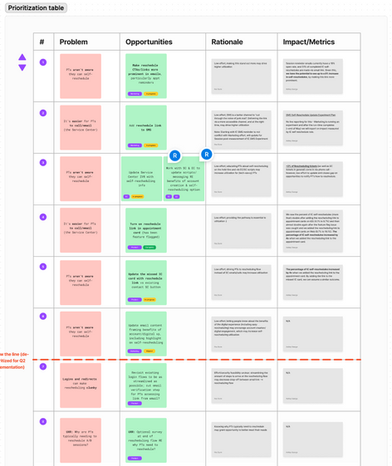AbleTo
Resolving service gaps to increase participant self-rescheduling
The problem
Rescheduling requests make up the majority of AbleTo's service center tickets, and also contribute to provider burden (out-of-session tasks). Additionally, no-show appointments negatively impact business (provider utilization & cost to serve) and provider morale. Rescheduling is a very common need for participants, but they weren't utilizing our digital tools to do so — and we weren't sure why. We needed to take a thorough look at the service experience to identify gaps and design solutions to positively impact self-rescheduling utilization and appointment adherence.
"It's easier to text my provider or call."
"I didn't know I could reschedule my appointment."
Rescheduling service blueprint (final discovery phase asset)
Final assets can appear simple, but the process is not. How did we get here?
FIRST
Connecting project goals to OKRs & past research
To begin this work, we defined clear project goals connected to a subset of AbleTo's 2023 OKRs. To balance these key business goals with the user(s) perspective, I resurfaced existing provider and participant persona research and high-level journey maps to ground our next steps.
NEXT
Investigating rescheduling analytics & mapping high-level flows
Since we didn't know why participants weren't using our digital tooling (problems yet to be defined), going deep into our rescheduling analytics was a very important part of the initial discovery work. After creating a framework of questions, we were able to dive into Looker and FullStory begin crafting that data story. This sparked new questions, hypotheses, and also helped determine our potential impact (from a metrics perspective). At the same time, I began documenting some of the high-level funnels and journeys leading to our rescheduling flow — particularly interested in our email marketing communications.
THEN
Two design workshops (service blueprinting & prioritization)
In the next phase of the project, I facilitated a two-part workshop. During the first session, we we reviewed and filled out the service blueprint I created, focusing the majority of our time on painpoints and opportunities. The blueprint covers the following journeys:
-
Primary success path [most common today]: A participant reschedules their IC (initial consultation) with the Service Center
-
Secondary success path [what we would like to happen]: A participant self-reschedules their IC
-
Problem path [what we know needs fixing]: A participant doesn't show up to their scheduled IC
During our next session, having defined problems and ideated on solutions, we analyzed the impact & effort of our various ideas to identify a short-list of solutions to pursue that had high-enough impact, with low-enough effort.
FINALLY
Delivering service design recommendations & implementing solutions
As a service design project, many of our "outcomes" were recommendations for departments beyond the scope of my product team. To bring this work across the finish line, I collaborated with these departments to design and implement changes. This included:
-
Marketing email updates & SMS links
-
Engagement & Service Center script/messaging updates
-
Fixed reschedule links within the product experience
As a post script, I had recently worked on the rescheduling flow itself, which I've included below as well.
Final thoughts...
As a designer who thrives in the research and discovery phases of the design cycle, this project was a lot of fun for me. I love trying out new frameworks, and teaching others about new and different methodologies along the way.
AbleTo has a complicated ecosystem, and service blueprinting proved to be a successful method for holistically framing and uncovering how the participant, provider, and business ops experiences converge — in the context of rescheduling. I look forward to monitoring our changes as they go live, and to see if we are able to reach our projected potential impact (for increasing participant self-rescheduling).





















